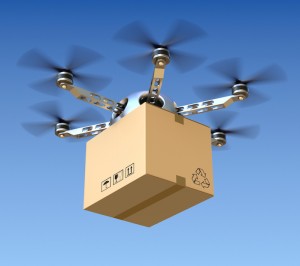 From robots to smartphones that are becoming smarter than humans, technology is rapidly and seamlessly making an impact in our everyday life. The newest advancement zipping around towns and cities involves parcel deliveries – by drones. While this technology is poised to revolutionize the service and delivery industry, several technological and regulatory challenges need to be addressed, including the Federal Aviation Administration’s restrictions prohibiting the use of unmanned aerial vehicles (UAVs) for commercial purposes.
From robots to smartphones that are becoming smarter than humans, technology is rapidly and seamlessly making an impact in our everyday life. The newest advancement zipping around towns and cities involves parcel deliveries – by drones. While this technology is poised to revolutionize the service and delivery industry, several technological and regulatory challenges need to be addressed, including the Federal Aviation Administration’s restrictions prohibiting the use of unmanned aerial vehicles (UAVs) for commercial purposes.
Delivery via drone
To help provide an efficient blueprint for companies to follow into the future, Chase Murray, assistant professor in the Department of Industrial and Systems Engineering, is examining operational execution associated with drone parcel delivery. His research has led him to develop algorithms he hopes will benefit the drone-based delivery of goods, as well as implement or improve military drone operations that maximize performance and minimize human intervention.
“There are many researchers working to overcome the technical hurdles associated with making robots fly safely for the purposes of parcel delivery,” said Murray. “Although I’m fascinated by recent technological advances, my interest is figuring out how to leverage those technologies to make logistics systems more efficient. It seems counterintuitive to think of UAVs requiring human assistance, but they require significant manpower to monitor and direct their operations.”
One of the fundamental constraints of battery-powered UAVs involves their relatively short flight capabilities, with most limited to 30 minutes in the air. Another is in the size and weight of parcels being delivered. Indeed, not all deliveries can be carried by UAVs, and some parcels will always require delivery by conventional means. Murray’s work addresses these constraints by minimizing flight distances, and by looking at distribution centers that are located in close proximity to customers in densely populated urban areas.
“In cases where the distribution center is located far from customers, an alternative is to pair the UAV with a traditional truck. The delivery truck departs from the distribution center carrying a UAV and all customer parcels,” said Murray. “The challenge is to determine which customers should be visited by a delivery truck, and which should be served by a UAV. We have developed algorithms that optimize the coordinated delivery schedules of both vehicles, allowing the UAV to take off from and return to a mobile delivery truck.”
Murray used the traveling salesman problem (TSP), a traditional computational mathematics theory used for optimization research formulated in 1930. The TSP finds the shortest route for a person to visit each customer and then returns the salesman back to a starting point. For Murray’s research, named the flying sidekick traveling salesman problem, optimal customer assignments must be determined for a UAV working in tandem with a delivery truck.
By allowing the UAV to launch from a truck rather than from a warehouse, the UAV’s range is effectively increased. Such a delivery system is expected to provide faster receipt of customer orders at less cost to the distributor with reduced environmental impacts. Routes generated by Murray’s algorithm are also expected to reduce the miles driven by delivery trucks.
Amanda Chu, a senior in industrial and systems engineering and founding president of Auburn’s student chapter of the Institute for Operations Research and the Management Sciences, partnered with Murray on this research and helped develop and test the mathematical models.
“This was my first research project, and I was excited Dr. Murray asked me to assist,” said Chu. “The best parts of this experience included learning new programming languages and knowing that my contributions advanced the research. After taking the model, formulating it into code and testing and experimenting with dozens of sets of data, I learned the problem was solvable. It was gratifying to see the results of my work. This experience has opened my eyes and helped me understand what research is about. I feel much more confident about my decision to attend graduate school in the near future.”
Military drone manpower
As UAVs become more prevalent, especially for military use, it’s inevitable UAV operators will experience occupational burnout because of the increasing number of flights placed under a single controller. Murray’s research seeks to address this challenge by incorporating operator workload considerations into the routes assigned to UAVs, thereby increasing operator efficiency and limiting operator stress.
“One challenge is to make sure operators do not become overwhelmed with an untenable number of activities to perform simultaneously,” said Murray. “Our optimization models seek to balance workload by properly scheduling both the operator and the UAV’s tasks.”
These optimization models break down multiple, simultaneous UAV missions into component tasks and account for the complexity and the time sensitivity. An algorithm then derives the number of operators necessary based on the number of tasks needed to be simultaneously directed. This minimizes the number of operators required for UAV direction while ensuring operators are not overloaded at critical points in the UAV mission.
“While this research has been motivated by military operations and missions executed by Predator and Reaper unmanned aircraft systems, the models developed may be adapted to other applications where man and machine interact,” added Murray. “One example is a manufacturing environment where a single worker must manage multiple machines. Proper scheduling of the jobs assigned to each machine can reduce a worker’s mental workload.”
Through Murray’s continued research in drone efficiency and endurance, the TV show “The Jetsons” may not be too far off from our future reality.